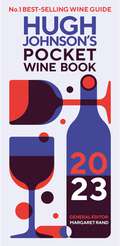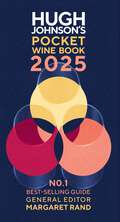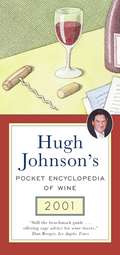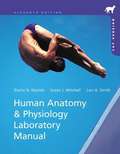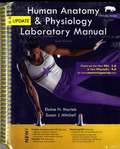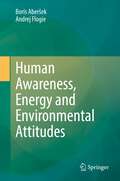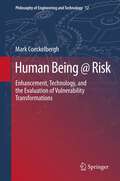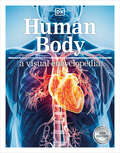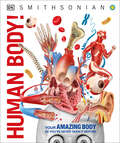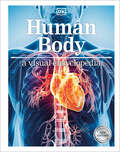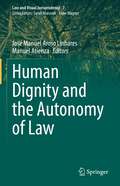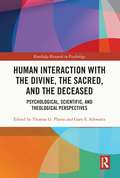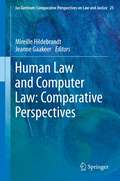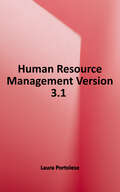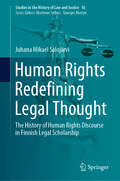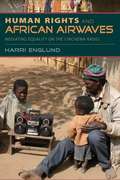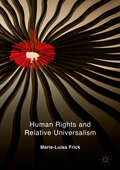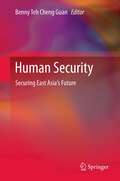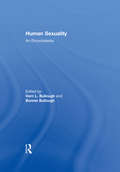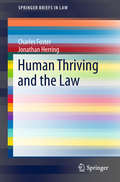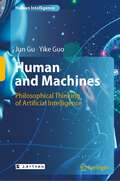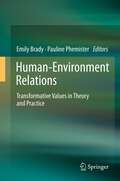- Table View
- List View
Hugh Johnson's Pocket Wine Book 2023
by Hugh Johnson Margaret RandThe world's best-selling annual wine guide.Hugh Johnson's Pocket Wine Book is the essential reference book for everyone who buys wine - in shops, restaurants, or on the internet. Now in its 46th year of publication, it has no rival as the comprehensive, up-to-the-minute annual guide.This latest edition of Hugh Johnson's Pocket Wine Book includes a color supplement: How Wine Ages (And Why), which covers questions such as whether aged wine is necessarily better wine and how to store wine to ensure it ages well. It provides clear succinct facts and commentary on the wines, growers and wine regions of the whole world. It reveals which vintages to buy, which to drink and which to cellar, which growers to look for and why. Hugh Johnson's Pocket Wine Book gives clear information on grape varieties, local specialities and how to match food with wines that will bring out the best in both.
Hugh Johnson's Pocket Wine Book 2025: The No1 Bestselling Guide
by Hugh Johnson Margaret Rand'A thorough guide to just about everything worth drinking.' The Times'Space for only one wine book in your life? This is it.' Howard G. Goldberg, The New York TimesTHE WORLD'S BESTSELLING ANNUAL WINE GUIDE Hugh Johnson's Pocket Wine Book is the essential reference book for everyone who buys wine - in shops, restaurants, or on the internet. Now in its 48th year of publication, it has no rival as the comprehensive, up-to-the-minute annual guide to wine.Providing clear succinct facts and commentary on the wines, growers and wine regions of the whole world, the book also reveals which vintages to buy, which to drink and which to cellar, as well as the best growers to look for and why. Hugh Johnson's Pocket Wine Book 2025 gives clear information on grape varieties, local specialities and how to match food with wines that will bring out the best in both.This latest edition of Hugh Johnson's Pocket Wine Book includes a colour supplement on Pinot Noir, the world's most highly prized grape, discussing everything from variety and food pairings, to Pinot Noir sparkling wines and how climate change has affected the production of this grape.
Hugh Johnson's Pocket Wine Book 2025: The No1 Bestselling Guide
by Hugh Johnson Margaret Rand'A thorough guide to just about everything worth drinking.' The Times'Space for only one wine book in your life? This is it.' Howard G. Goldberg, The New York TimesTHE WORLD'S BESTSELLING ANNUAL WINE GUIDE Hugh Johnson's Pocket Wine Book is the essential reference book for everyone who buys wine - in shops, restaurants, or on the internet. Now in its 48th year of publication, it has no rival as the comprehensive, up-to-the-minute annual guide to wine.Providing clear succinct facts and commentary on the wines, growers and wine regions of the whole world, the book also reveals which vintages to buy, which to drink and which to cellar, as well as the best growers to look for and why. Hugh Johnson's Pocket Wine Book 2025 gives clear information on grape varieties, local specialities and how to match food with wines that will bring out the best in both.This latest edition of Hugh Johnson's Pocket Wine Book includes a colour supplement on Pinot Noir, the world's most highly prized grape, discussing everything from variety and food pairings, to Pinot Noir sparkling wines and how climate change has affected the production of this grape.
Hugh Johnson’s Pocket Encyclopedia of Wine 2001
by Hugh JohnsonAn indispensable tool of the wine enthusiast, Hugh Johnson's Pocket Encyclo- pedia of Wine 2001 is thoroughly revised to provide the most up-to-date information. This 24th edition of the world's bestselling wine book gives expert help in choosing a wine for every occasion and every budget. With current information on more than 6,000 wines, growers, and regions worldwide, the Pocket Encyclopedia is packed with advice to assist your selection of wine, whether in stores or restaurants, for cellaring, or for special events. Extensive coverage -- from re-emerging Eastern European regions to the newest additions in the United States -- will introduce even the experienced oenophile to little-known finds, while detailed entries clarify information for the novice. Johnson names the top-valued wines from every country and highlights those to drink in 2001, with predictions for wines to watch for in the future. Also included are regional maps, label guides, and vintage charts, along with fascinating entries on the history, production, and appreciation of wine. Hugh Johnson's Pocket Encyclopedia of Wine 2001 is the peerless standard of wine guides, a crucial addition to the library of every wine lover, enthusiast, and connoisseur.
Human Anatomy & Physiology Laboratory Manual: Cat Version
by Elaine N. Marieb Susan J. Mitchell Lori A. SmithThis lab manual gives students a complete hands-on laboratory and learning experience inside and outside of the lab. The new edition has been fully revised with even more accessible language and more than 50 new and improved cadaver and histology photos. It also features engaging new Group Challenge activities that encourage a more active learning experience in the lab.
Human Anatomy & Physiology Laboratory Manual: Fetal Pig Version 10th Edition update
by Elaine N. Marieb Susan J. MitchellThis manual, intended for students in introductory human anatomy and physiology courses, presents a wide range of laboratory experiences.It also contains the background discussions and terminology necessary to perform all experiments.
Human Awareness, Energy and Environmental Attitudes
by Boris Aberšek Andrej FlogieThis book raises awareness about environmental issues that result from energy production, extraction and conversion, and examines the attitudes people have about these issues. It discusses societal and educational relations associated with energy and environmental issues, focusing on philosophical, sociological and psychological views, and provides an analysis of how the individual and the society perceive, process and analyze the information on this subject. The authors present the concept of environmentally conscious engineering, discussing various forms of energy extraction and production, and detail alternative, under-researched and unaffordable solutions, such as nuclear fusion and artificial photosynthesis. The book also touches on topics such as the storage of energy and greenhouse gases, recycling and reuse of energy waste, and energy saving and efficiency. The book will be of interest to students and researchers of environmentally conscious engineering, energy use, and human dimensions of ecology and the environment, as well as NGOs, policy makers, and environmental activists.
Human Being @ Risk: Enhancement, Technology, and the Evaluation of Vulnerability Transformations
by Mark CoeckelberghWhereas standard approaches to risk and vulnerability presuppose a strict separation between humans and their world, this book develops an existential-phenomenological approach according to which we are always already beings-at-risk. Moreover, it is argued that in our struggle against vulnerability, we create new vulnerabilities and thereby transform ourselves as much as we transform the world. Responding to the discussion about human enhancement and information technologies, the book then shows that this dynamic-relational approach has important implications for the evaluation of new technologies and their risks. It calls for a normative anthropology of vulnerability that does not ask which objective risks are acceptable, how we can become invulnerable, or which technologies threaten human nature, but which vulnerability transformations we want. To the extent that we can steer the growth of new technologies at all, this tragic and sometimes comic project should therefore be guided by what we want to become.
Human Body A Visual Encyclopedia
by DKUnderstand the human body from head to toe with this educational encyclopedia for children.Get to know how each part of the body works through amazing facts and colorful diagrams in this fully updated edition of the bestselling Human Body A Visual Encyclopedia.Did you know that you are made up of 100 trillion cells? Learn about blood vessels (capillaries, veins, and arteries) which, if they were laid out end to end, would wrap around the Earth twice! Find out what makes a balanced diet - after all, you will eat about 20 tons of food in your entire life!This human body book for kids offers: How the body works, looking at body parts and functions like bones and muscles, heart and blood, disease defenses, the life cycle, and much more.A human body encyclopedia that is suitable and informative for children aged 9+.A refreshed and updated edition, including a new design and the latest facts and stats on the human body.Make your way from the skin, muscles, organs, and bones, right down to your cells and DNA with this encyclopedia that combines clear descriptions of human biology with awesome photographs, diagrams, and CGI artworks. There are also fun quizzes, so you can assess your own personality and test your logical and reasoning skills.Explore the series!Globally, the Children’s Encyclopedia series has sold more than 4 million copies worldwide. Uncover the marvels of our world with Science, explore the deep blue with Ocean, explore our solar system and beyond with Space, and get to grips with world-famous sculptures with Art.
Human Body! (DK Knowledge Encyclopedias)
by DKExplore the human body as you&’ve never known before with this ultimate kid&’s guide to what goes on under our skin. Forming part of a fantastic series of kid's educational books, this bold and brilliant kid's encyclopedia uses ground-breaking CGI imagery to reveal the human body as you've never seen it before. Informative, diverse in subject matter, easy-to-read and brimming with beautiful graphics, young learners can explore the incredibly detailed cross-sections and cutaways that reveal the inner workings of these fascinating and complex machines we know as our bodies!This charming children&’s encyclopedia opens the world in new ways, with: - Packed with facts, charts, infographics and illustrations that cover the human body head to toe- Encompassing a visual approach with illustrations, photographs and extremely detailed 3D CGI images- Crystal clear text distills the key information.- DK's encyclopedias are fact-checked by subject experts to offer accuracy beyond online sources of information.This fully-updated edition of Knowledge Encyclopedia Human Body! is the perfect encyclopedia for children aged 9-12, ideal for inquisitive minds, with a unique head-to-toe approach that makes the complex structure of the human body both appealing and accessible for curious young readers. Jam-packed with fun facts about the human body, including creative CGI artworks that can be rotated and animated to bring the aspects of this body book to life! Curious children can take a look at the life of a cell, discover the digestive system, and learn all about record-breaking bodies!Explore, Discover And Learn!DK's Knowledge Encyclopedia Human Body! uncovers the marvels of our body in unprecedented detail and with stunning realism. Encompassing engaging facts about the human body, including a closer look at each bodily system, such as the nervous system, muscle system and more, and exploring a timeline of medical milestones, you can spend quality time exploring the wonders of the human body with children, accompanied by impressive visuals to engage their senses. A must-have volume for curious kids with a thirst for knowledge, this enthralling encyclopedia is structured in such a way that your child can read a bit at a time, and feel comfortable to pause and ask questions. Doubling up as the perfect gift for young readers, who are always asking questions about our planet! At DK, we believe in the power of discovery. This thrilling kid&’s encyclopedia is part of the Knowledge Encyclopedia educational series. Celebrate your child&’s curiosity as they complete the collection and discover diverse facts about the world around them. Dive into the deep blue with Knowledge Encyclopedia Ocean! Travel back in time to when dinosaurs roamed the earth with Knowledge Encyclopedia Dinosaur! And hone your knowledge on how the human body works with Knowledge Encyclopedia Human Body! Whatever topic takes their fancy, there&’s an encyclopedia for everyone!
Human Body: A Visual Encyclopedia (DK Children's Visual Encyclopedias)
by DKLook inside yourself for the first time with the ultimate body book for children. From the hair on your head to the tips of your toes, this essential encyclopedia explores the super science going on under your skin.Did you know your amazing body consists of 100 trillion cells? Or that your blood vessels laid out end to end would wrap around planet Earth twice? And that you&’ll munch through 20 tonnes of food in your lifetime? Find out all this and much more on the epic journey of self-discovery, not forgetting your heads, shoulders, knees, and toes! During this introduction to anatomy, you&’ll stop off to see the different organs and systems designed to keep us going all day long. Check out the brilliant brain in action at the body&’s control center, the heart that never stops beating, the huge lungs filling with air to breathe, and the strong skeleton that keeps you from turning to jelly. Peel back the layers as you go deeper into the muscles, bones, cells, and finally, the DNA that makes you different from everyone else. This international best-seller has been fully updated to include the latest research on the human body. Stunning photographs, CGI artworks, and eye-catching graphics work together with accessible text, fun-filled facts, and quirky quizzes to ensure an exciting and educational experience that is second to none. This brilliant body book is the perfect study aid or homework help – and you&’ll never see yourself in the same way again!Supports the Common Core State Standards.
Human Dignity and the Autonomy of Law (Law and Visual Jurisprudence #7)
by Manuel Atienza José Manuel Aroso LinharesThis book intertwines two major themes in contemporary legal theory – the concepts of human dignity and the problem of the autonomy and limits of the law – while also addressing two other key aspects – the first one concerned with human rights practices and foundations (in their direct connections with the issue of dignity), the second one considering the role that the law’s aspirations attribute to the experience of an autonomous subject-person (and the demands that identify his/her position in the dialectical counterpoint with the rethinking of a community). The diversity of perspectives that each of these themes allows is explored in various contexts and with unmistakable implications concerning juridical validity, rule of law practices, pluralism, political and practical-cultural challenges, and divisive “bio-ethical” issues. This means considering the separation or separability theses between law and morality and the juridically relevant experience of person(hood) as a dialectic between autonomy and responsibility, the orthodox and heterodox images of comparable concreteness and incomparable singularity, the challenges of external points of view and interdisciplinary approaches.
Human Evolution
by Graeme FinlayControversy over human evolution remains widespread. However, the human genome project and genetic sequencing of many other species have provided myriad precise and unambiguous genetic markers that establish our evolutionary relationships with other mammals. Human Evolution: Genes, Genealogies and Phylogenies identifies and explains these identifiable, rare and complex markers including endogenous retroviruses, genome-modifying transposable elements, gene-disabling mutations, segmental duplications and gene-enabling mutations. The new genetic tools also provide fascinating insights into when and how many features of human biology arose: from aspects of placental structure, vitamin C dependence and trichromatic vision, to tendencies to gout, cardiovascular disease and cancer. Bringing together a decade's worth of research and tying it together to provide an overwhelming argument for the mammalian ancestry of the human species, the book will be of interest to professional scientists and students in both the biological and biomedical sciences.
Human Interaction with the Divine, the Sacred, and the Deceased: Psychological, Scientific, and Theological Perspectives (Routledge Research in Psychology)
by Gary E. Schwartz Thomas G. PlanteHuman Interaction with the Divine, the Sacred, and the Deceased brings together cutting-edge empirical and theoretical contributions from scholars in fields including psychology, theology, ethics, neuroscience, medicine, and philosophy, to examine how and why humans engage in, or even seek spiritual experiences and connection with the immaterial world. In this richly interdisciplinary volume, Plante and Schwartz recognize human interaction with the divine and departed as a cross-cultural and historical universal that continues to concern diverse disciplines. Accounting for variances in belief and human perception and use, the book is divided into four major sections: personal experience; theological consideration; medical, technological, and scientific considerations; and psychological considerations with chapters addressing phenomena including prayer, reincarnation, sensed presence, and divine revelations. Featuring scholars specializing in theology, psychology, medicine, neuroscience, and ethics, this book provides a thoughtful, compelling, evidence-based, and contemporary approach to gain a grounded perspective on current understandings of human interaction with the divine, the sacred, and the deceased. Of interest to believers, questioners, and unbelievers alike, this volume will be key reading for researchers, scholars, and academics engaged in the fields of religion and psychology, social psychology, behavioral neuroscience, and health psychology. Readers with a broader interest in spiritualism, religious and non-religious movements will also find the text of interest.
Human Law and Computer Law: Comparative Perspectives
by Jeanne Gaakeer Mireille HildebrandtThe focus of this book is on the epistemological and hermeneutic implications of data science and artificial intelligence for democracy and the Rule of Law. How do the normative effects of automated decision systems or the interventions of robotic fellow 'beings' compare to the legal effect of written and unwritten law? To investigate these questions the book brings together two disciplinary perspectives rarely combined within the framework of one volume. One starts from the perspective of 'code and law' and the other develops from the domain of 'law and literature'. Integrating original analyses of relevant novels or films, the authors discuss how computational technologies challenge traditional forms of legal thought and affect the regulation of human behavior. Thus, pertinent questions are raised about the theoretical assumptions underlying both scientific and legal practice.
Human Resource Management Version 3.1
by Laura PortoleseThis textbook includes Online Access, Quizzes, Flashcards and Homework (if professor uses Homework system). Human Resource Management is structured to provide the necessary academic background information about managing people resources while also lending valuable insights from a practitioner’s perspective that encompasses both large and small businesses.
Human Rights Redefining Legal Thought: The History of Human Rights Discourse in Finnish Legal Scholarship (Studies in the History of Law and Justice #16)
by Juhana Mikael SalojärviThis book investigates the origins and development of human rights discourse in Finnish legal scholarship in the twentieth century. It provides a detailed account of how human rights were understood before they had legal relevance in a positivist sense, how they were adapted to Finnish legal thinking in the post-Second World War decades, how they developed into a mode of legal rhetoric and a type of legal argument during the 1970s and 1980s, and how they eventually became a significant paradigm in legal thinking in the 1990s. The book also demonstrates how rights discourse infiltrated the discussion regarding problems that were previously addressed in arguments concerning morals, social justice and equity. Although the book focuses on the history of Finnish legal scholarship, it is also interesting from a global perspective for two reasons: Firstly, it demonstrates how an idea of international law is transplanted and diffused into national legal thinking; Finland is an illustrative example in this regard. Secondly, it offers insights into the general history of human rights.
Human Rights and African Airwaves: Mediating Equality on the Chichewa Radio
by Harri EnglundHuman Rights and African Airwaves focuses on Nkhani Zam'maboma, a popular Chichewa news bulletin broadcast on Malawi's public radio. The program often takes authorities to task and questions much of the human rights rhetoric that comes from international organizations. Highlighting obligation and mutual dependence, the program expresses, in popular idioms and local narrative forms, grievances and injustices that are closest to Malawi's impoverished public. Harri Englund reveals broadcasters' everyday struggles with state-sponsored biases and a listening public with strong views and a critical ear. This fresh look at African-language media shows how Africans effectively confront inequality, exploitation, and poverty.
Human Rights and Relative Universalism
by Marie-Luisa FrickThis book argues that human rights cannot go global without going local. This important lesson from the winding debates on universalism and particularism raises intricate questions: what are human rights after all, given the dissent surrounding their foundations, content, and scope? What are legitimate deviances from classical human rights (law) and where should we draw “red lines”? Making a case for balancing conceptual openness and distinctness, this book addresses the key human rights issues of our time and opens up novel spaces for deliberation. It engages philosophical reasoning with law, politics, and religion and demonstrates that a meaningful relativist account of human rights is not only possible, but a sorely needed antidote to dogmatism and polarization.
Human Security: Securing East Asia's Future
by Benny Teh Cheng GuanHuman security is becoming increasingly pronounced in recent years due to changes in the security landscape of world politics. Yet, inter-state relations have continued to dominate security concerns in East Asia. This has, unfortunately, eluded the broader understanding of issues and challenges facing the peoples of East Asia. Home to nations with rapid economic growth and development, East Asia is at the core of what some individuals have termed as the coming Asian Century. Years of economic liberalization and exposure to globalization have permitted the region to achieve high levels of interconnectedness from within and without in unprecedented ways. This has certainly reduced state control and opened up spaces for cross-border human activities. While economic wealth have increased substantially over the years, it has also brought about bigger income disparities, unsustainable safety nets and a surge in social problems from health issues to migratory concerns that threaten the safety and well-being of individuals. Human Security: Securing East Asia's Future timely examines the fundamental issues causing human insecurities and evaluates the extent of which human security plays a role at the state and regional levels. Covering the different areas of threats to humans and applying case study materials, this volume provides an intellectual mix of perspectives that captures the relationship between people, state and region. This book will be of interest to those studying traditional and non-traditional security/threats, Asian human development and critical policy analysis.
Human Sexuality: An Encyclopedia (New Concepts In Human Sexuality Ser.)
by Vern L. Bullough Bonnie BulloughFirst Published in 1994. The purpose of an encyclopedia is to gather in one place information that otherwise would be difficult to find. Bring together a collection of articles that are authoritative and reflect a variety of viewpoints. The contributors come from a wide range of disciplines— from nursing to medicine, from biology to history— and include sociologists, psychologists, anthropologists, political scientists, literary specialists, academics and non-academics, clinicians and teachers, researchers and generalists.
Human Thriving and the Law (SpringerBriefs in Law)
by Charles Foster Jonathan HerringThe idea of the Good Life – of what constitutes human thriving, is, implicitly, the foundation and justification of the law. The law exists to hold societies together; to hold in tension the rights of individuals as against individuals, the rights of individuals as against various types of non-humans such as corporations (and vice versa), and the rights of individuals individuals as against the state (and vice versa). In democratic states, laws inhibit some freedoms in the name of greater, or more desirable freedoms. The only justification for law is surely that it tends to promote human thriving. But what is the Good Life? What does it mean to live a thriving life? There has been no want of discussion, at least since the great Athenians. But surprisingly, since human thriving is its sole raison d’etre, the law has been slow to contribute to the conversation. This book aims to start and facilitate this conversation. It aims to: -make lawyers ask: ‘What is the law for?’, and conclude that it is to maximise human thriving -make lawyers ask: ‘But what does human thriving mean?’ -make judges and advocates ask: ‘How can a judgment about the best interests of a patient be satisfactory unless its basis is made clear?’
Human and Machines: Philosophical Thinking of Artificial Intelligence (Human Intelligence)
by Yike Guo Jun GuThis book shares Chinese scholars’ philosophical views on artificial intelligence. The discussions range from the foundations of AI—the Turing test and creation of machine intelligence—to recent applications of AI, including decisions in games, natural languages, pattern recognition, prediction in economic contexts, autonomous behaviors, and collaborative intelligence, with the examples of AlphaGo, Microsoft’s Xiao Bing, medical robots, etc. The book’s closing chapter focuses on Chinese machines and explores questions on the cultural background of artificial intelligence. Given its scope, the book offers a valuable resource for all members of the general public who are interested in the future development of artificial intelligence, especially from the perspective of respected Chinese scholars.
Human-Environment Relations
by Emily Brady Pauline PhemisterThis fresh and innovative approach to human-environmental relations will revolutionise our understanding of the boundaries between ourselves and the environment we inhabit. The anthology is predicated on the notion that values shift back and forth between humans and the world around them in an ethical communicative zone called 'value-space'. The contributors examine the transformative interplay between external environments and human values, and identify concrete ways in which these norms, residing in and derived from self and society, are projected onto the environment.
